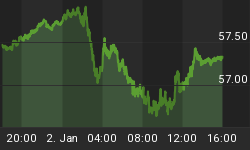For several months, we have been suggesting to readers that they should view gold as a long-term value buy. The strong rally in February helped confirm that view, and it also caused us to reevaluate our big-picture forecast. Based on the way gold prices broke out of the downward pattern that had occupied most of 2015, we believe gold has put in a real, durable low. Moreover, our primary Elliott wave count now reflects our conclusion that gold is preparing for a "third wave" climb that could last several years.
Before we get to the long-range forecast, let us first explain briefly how the decline from 2011 can be counted as complete. The series of large swings that lasted from mid-2013 to late 2014 on the weekly chart, shown below, counts well as a complex correction. Each segment - 'w', 'x', and 'y' - consists of three sub-waves. On a smaller scale, each of those sub-waves also consists of three smaller sub-sub-waves. The segments of the correction add up to be a corrective fourth wave inside a larger downward impulse.
After the completion of the fourth wave, labeled as (iv) near the end of 2014, price formed a series of overlapping moves that traced out an ending diagonal fifth wave - a terminal pattern. Although we were unsure that the pattern was complete until recently, the fact that the February rally broke the upper boundary of the diagonal confirms that it is complete. The rally itself represents the first wave of a new upward pattern.
While we believe the trend is changing, it is still important to shop for good entry prices if thinking long. Gold is approaching Gann square-of-nine resistance levels at $1,284 and $1,320, and it is also nearing the high point of its 48-week cycle. It may be best to look for entries later in the year, and to watch standard retracement levels.
Turning to the long-range forecast, the monthly chart below shows how present rally may turn out to be just a small part of a much larger series of upward impulsive waves. Keeping things in their proper scale, we would like to see a five-wave 'i'-'ii'-'iii'-'iv'-'v' move upward to form larger wave (i). Then we would like to see larger wave (i) become the first part of an even larger five-wave (i)-(ii)-(iii)-(iv)-(v) structure, which probably would be wave '3' of a much larger five-wave structure.
Treating the count as being on the verge of a big upward wave '3' implies that gold will not see new lows for a very long time. Although there are valid Elliott wave alternative counts going forward that would allow for new lows sometime late in the present decade or early in the next decade, we think the economic environment will not favor those scenarios. There is a limit to how high the price of gold can go in Dollars if the Dollars themselves are becoming more valuable. Eventually the metal should prevail.
Our newsletter this month discusses the big picture in interest rates and treasuries. Click here to request your copy!


















